Note: Measurements taken in the anechoic chamber at Canada's National Research Council can be found through this link.
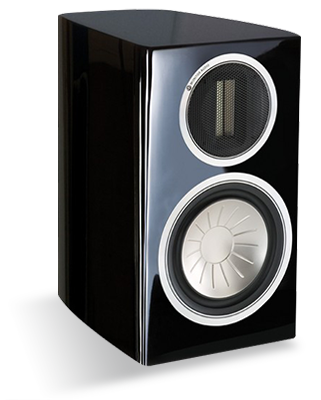 My review of Monitor Audio’s Silver 6 loudspeaker was published on SoundStage! Access on August 1, 2014. When I arrived home from work later that day, my inbox contained the following e-mail:
My review of Monitor Audio’s Silver 6 loudspeaker was published on SoundStage! Access on August 1, 2014. When I arrived home from work later that day, my inbox contained the following e-mail:
its quite obvious you have a positive bias to Monitor Audio.
your reviews are bordering on.....boring.
I am betting you are receiving compensation for Ma/Kevro.
After all resews sell...Right
Although I wasn’t thrilled to hear it -- especially in a message containing so many typos -- I could handle that this reader had found my writing boring. What bothered me was that this person had questioned my integrity as a reviewer, based on an assumption that my generally positive comments about Monitor Audio speakers could mean only that I must be in the company’s back pocket. Perhaps I should have been flattered that someone would think my boring reviews worthy of endorsement by an audio company, but the fact is, I have never been paid to recommend a product.
There is such a thing as a house sound. Speaker and electronics manufacturers typically aim to achieve certain objectives, regardless of the level of product they’re designing and building. Obviously, in different products these goals are realized to lesser or greater extents, but in my experience, most companies have a general notion of what they consider good sound. They don’t try to reinvent the wheel each time they design something new.
Monitor Audio has a house sound (see below). It’s a sound I’ve appreciated since 2007, when I first heard their Silver RS6 speaker. The subject of this review is the Gold GX50, the smallest model in Monitor’s Gold GX series, and little brother to the Gold GX100, which I wrote about in 2012. Having spent the past few weeks with the Gold GX50s, I still have great admiration for Monitor Audio speakers, so those who question my motives as a reviewer can save some time and stop reading now. For those who want to hear more about a pretty impressive pair of speakers, here’s what I learned.
Description
Monitor Audio’s Gold GX50 ($1800 USD per pair) measures a mere 11.7”H x 6.6”W x 10.25”D, but tips the scales at a sturdy 16.5 pounds. Its well-braced cabinet is made of 20mm-thick MDF -- hard raps of my knuckles against the side panels were met with dull thuds, a good indication of solid construction. In my review of the Gold GX100 I waxed poetic about its appearance, and since the Gold GX50 is aesthetically identical to its bigger brother, those same comments apply here. From the smoothly rounded edges of its impeccably finished cabinet to the clean look of its front baffle, accented by a silver ring around each driver, everything about the GX50 exudes quality and attention to detail. The review samples were finished in Piano Black Lacquer; their sophisticated, modern appearance got me thinking how good they might look in a study. Other finishes are available: Bubinga or Dark Walnut real-wood veneers, Piano Ebony or Piano White Lacquer. One should expect top-notch craftsmanship in an $1800/pair minimonitor. The Gold GX50 delivers that.
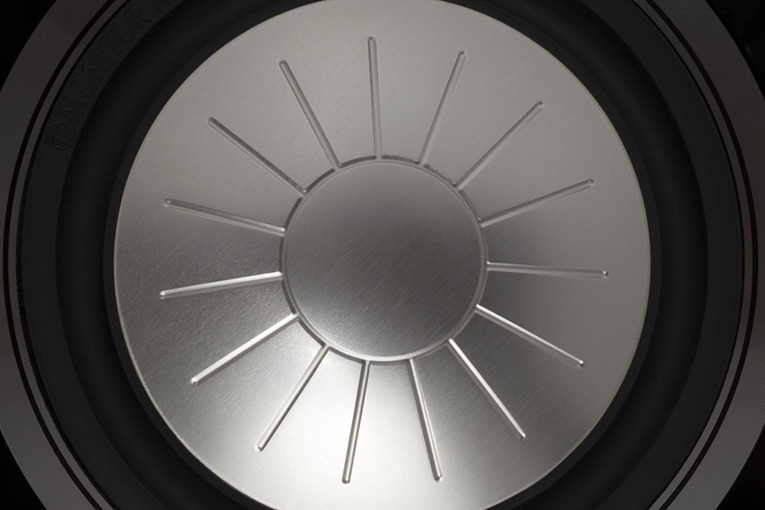
A two-way bass-reflex design, the Gold GX50 has a 5.5” C-CAM RST bass-midrange driver crossed over at 2.3kHz to a C-CAM ribbon tweeter. Monitor Audio adopted ceramic-coated aluminum magnesium (C-CAM) from the aerospace industry many years ago, and ever since has used it in their upper-end speaker drivers. This advanced alloy is highly rigid yet very lightweight -- ideal characteristics for any speaker driver. The purpose of Monitor’s Rigid Surface Technology (RST) is to increase the rigidity of the speaker cone with small, precise folds in its surface. In the Silver RS6 I reviewed, RST was manifested as a pattern of dimples over the surface of the drivers; in the Gold GX50, the RST folds appear as ribs radiating from the center of the cone toward the circumference. The more rigid cone is thus better able to maintain its shape, particularly at high output levels, where any sort of deformation in its surface would create distortion in the sound. Monitor claims that RST allows them to make their cones even thinner and lighter, which increases the drivers’ efficiency.
For their proprietary ribbon tweeter, Monitor Audio has suspended a thin membrane of C-CAM in a powerful magnetic field created by high-energy neodymium magnets. The ribbon acts as both the voice coil and the diaphragm, and with a mass of just 18mg, it can respond instantaneously to changes in the signal it is fed. Monitor specifies the GX50’s frequency response as 55Hz-60kHz -- if accurate, an impressively wide bandwidth for a relatively small speaker. The upper limit of 60kHz is remarkably high, even if such frequencies are well above the audioband (i.e., the range of human hearing).
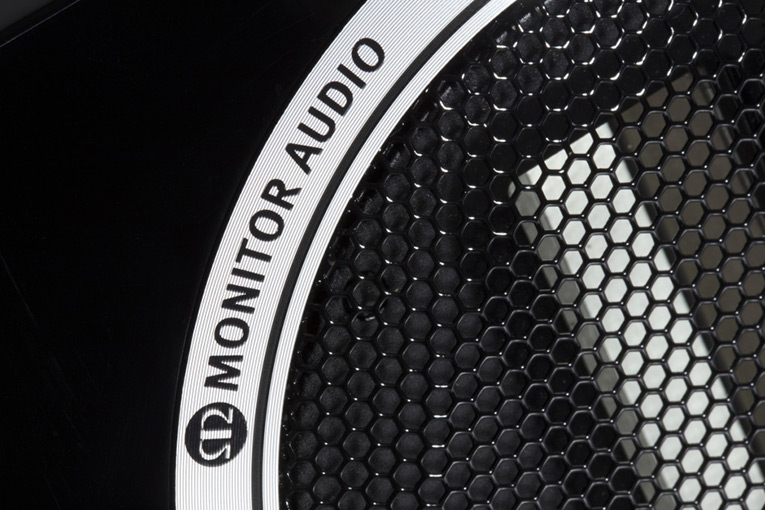
The GX50’s claimed sensitivity is 86dB/W/m, its nominal impedance an amplifier-friendly 8 ohms -- you shouldn’t need too much power to drive them. Monitor recommends using an amplifier capable of delivering 50-100Wpc of continuous power; I had no problem getting the speakers to sing with a Bryston B135 SST2 integrated amplifier rated at 135Wpc.
Each GX50 is supplied with two sets of binding posts that are among the nicest I’ve encountered. They accept banana plugs, spades, or bare wire, and give the user the option of biamplifying or biwiring the speakers. Above the binding posts is the same HiVe II port design found in all of Monitor’s Silver and Gold models. These ports’ shape and straight rifling are intended to accelerate the passage of air through them, to produce more agile bass while minimizing port noise. Metal speaker grilles were supplied, but I never used them. Fortunately, these attach magnetically to the baffles, leaving the naked façade free of any indication that it can accommodate a grille -- a small touch increasingly common in higher-end loudspeakers.
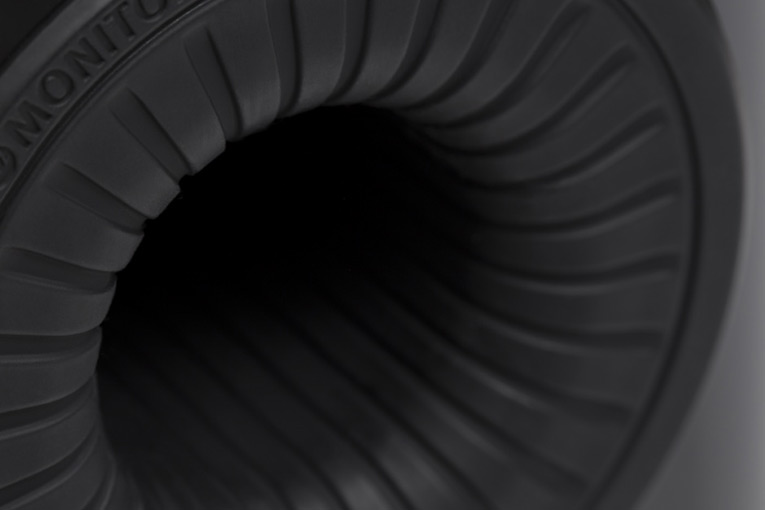
In addition to the aforementioned Bryston amp, to which the GX50s were connected with AudioQuest Comet speaker cables, my review system included an NAD C 565BEE CD player that served as a transport for a Bryston BDA-2 DAC, to which it was linked by an i2Digital X-60 digital coaxial interconnect. A MacBook computer ran Audirvana software, to provide the DAC with digital content via an AudioQuest Forest USB cable. The DAC was linked to the integrated with Kimber Kable Tonik interconnects. All electronics were plugged into an ExactPower EP15a power conditioner/regenerator.
Sonics
So what, exactly, is Monitor Audio’s house sound? The Gold GX50 is the fourth speaker I’ve reviewed from the British company, and one thing that has consistently stood out about all of them is their speed and outstanding transient response. If a speaker can be described as “fast,” the Monitors are fast. This character must be attributed at least in part to the choice of driver materials and the construction of the cabinet, but whatever the cause, the GX50, too, sounded quick. In addition to its wonderful sense of pace, the GX50s bore other hallmarks of the Monitor sound: superb retrieval of detail, precise imaging, and taut, punchy bass.
The GX50’s incisiveness and ability to carve out the leading edges of notes made it the perfect companion for listening to Jerry Garcia and David Grisman’s Shady Grove (CD, Acoustic Disc ACD-21). I often use this album in my reviews because, in addition to being great music, these tracks are well recorded. With “Louis Collins,” the Monitors did a wonderful disappearing act as music filled the space between and around the speakers. The musicians were spread across the front of the room as the GX50s outlined their positions with pinpoint precision. The plucks of various stringed instruments -- including acoustic guitar, mandolin, banjo, and bass guitar -- were crisp and clear, the timbre of each well articulated. Garcia’s voice was placed center stage, in the same plane as the speaker baffles, sounding open and natural, as if he could have been in the room. This track provided a good example of the wonderful quality of the GX50s’ midrange reproduction, which was notably clean and open, helping to bring voices to life with a sense of presence and space.
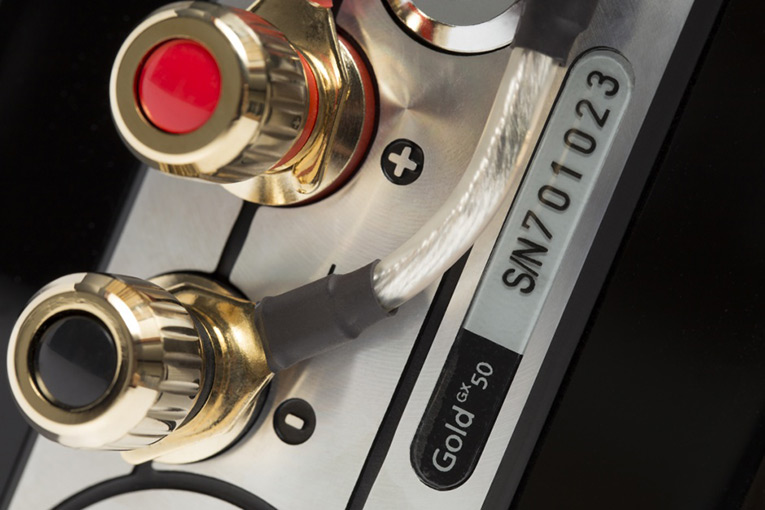
The GX50s did a fine job capturing the ambiance of Townes Van Zandt’s Live at the Old Quarter, Houston, Texas (CD, Fat Possum FP1118-2). These sessions were recorded over several nights in July 1973, and the intimacy of over a hundred people crammed into an 18’ x 38’ room on a hot summer night is palpable. In “White Freightliner Blues,” Van Zandt’s voice and acoustic guitar are portrayed front and center against the backdrop of an exuberant audience clapping in time with the music and clearly caught up in the moment. By the time Van Zandt covers Bo Diddley’s “Who Do You Love,” the sound of clapping is accompanied by hollers from the crowd as the energy in the room becomes infectious. The sound on this album is good but not great, and the GX50s did a nice job of getting out of the way, letting the music through without editorializing on it. By allowing me to hear the low-level sounds coming from the audience, the Monitors did a nice job of communicating what it must have been like to be in the crowd at this small venue more than 40 years ago.
With “Prologue,” from Loreena McKennitt’s The Book of Secrets (CD, Quinlan Road 19404), the GX50s again showcased two of their best attributes -- precise imaging and superb soundstaging -- by evoking a tangible sense of depth and sound that emanated from beyond the outer edges of the speakers to create a vast, three-dimensional stage. The GX50s were also commendable in their ability to sort out the somewhat complex arrangement of “Marco Polo,” such that each instrumental timbre was distinct and clear as day, occupying its own space before me. Listeners who value detailed sound will find much to appreciate in these speakers, whose clean sound made it easy to listen deep into the music to hear precisely what was going on.
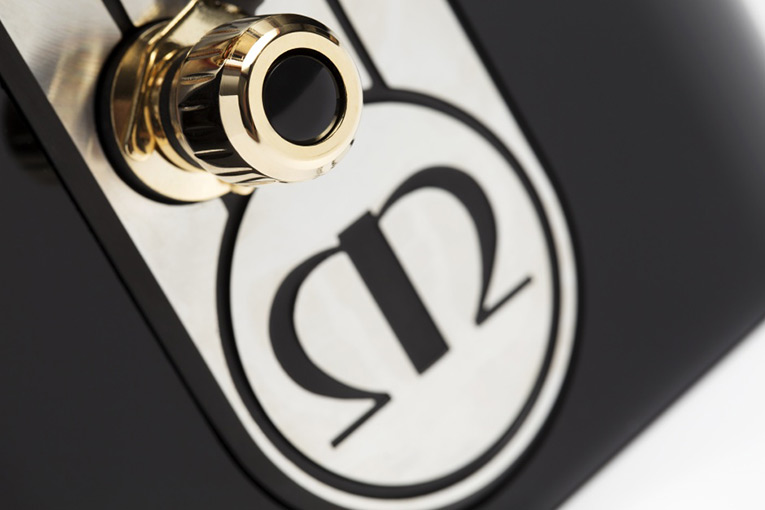
Given the GX50’s relatively small size, one thing that surprised me about it with “Prologue” was the drum, the sound of which had enough weight to underpin the music, while its reverberation gave a sense of the space in which it had been recorded. When I first set up the GX50s, I wasn’t satisfied with the amount of bass I was able to coax from their 5.5” drivers -- but moving them closer to the front wall helped augment their output down low. The trick was to maximize their bass while not moving them so close to the wall that I sacrificed their ability to image; in the end, I was able to strike a good balance. Within their limits, I found that percussion was well reproduced through the Monitor Audios, whose mid- to upper bass was agile and incisive, making it the perfect complement to the speakers’ overall excellent clarity.
Ultimately, however, the GX50’s bass production was limited -- something I was reminded of while listening to “Angel,” from Massive Attack’s Mezzanine (CD, Virgin 8 45599 2). The synthesized bass in this track digs deep, and while the GX50s provided enough energy down low to give it a foundation, they could only hint at how much bass this recording actually contains. Two 5.5” drivers can move only so much air, and no amount of repositioning changed that. If you want truly deep bass, you’ll need to add a subwoofer or consider a larger speaker.
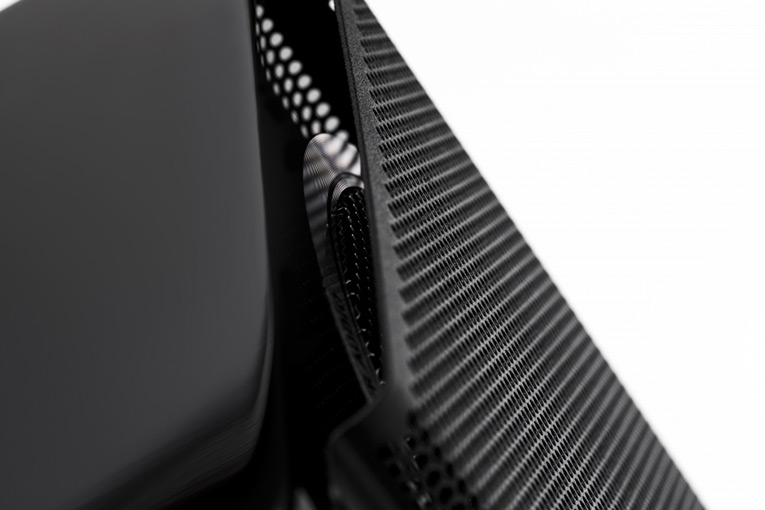
Nonetheless, just because the GX50 couldn’t play super deep, don’t assume that it didn’t sound dynamic. With War Dance, from the suite from Respighi’s Belkis, Queen of Sheba, performed by Eiji Oue and the Minnesota Orchestra (CD, Reference Recordings RR-95CD), the GX50s acquitted themselves quite well, keeping pace with the rapid-fire dynamic shifts of this rather fierce music. The speakers sounded so clean that they were able to illuminate each section of the orchestra, and allowed me to hear plenty of detail. In addition to the fact that there’s a lot happening in this music, War Dance has a pounding rhythm -- the Monitors did a fine job of conveying this performance’s sense of urgency. The bass they were able to reproduce was fast and punchy, with no sign of bloat or overhang. The GX50s sounded tight, and the instantaneous responses of tweeter and woofer to changes in the music gave them that quick sonic signature that I’ve always admired about Monitor Audio speakers -- that house sound.
Comparison
I compared the Monitor Audio Gold GX50 with Amphion’s Argon3L, a floorstanding design that costs two-and-a-half times more ($4500/pair). Like the GX50, the Argon3L is a two-way design: a 1” titanium-dome tweeter at the base of a deep waveguide, and a 6.5” aluminum midrange-woofer. The Finnish-made Argon3L is taller, wider, and deeper than the GX50, which looks tiny by comparison.
Given the discrepancy in size, it was no surprise that the Argon3Ls played deeper and with more weight than the GX50s. Furthermore, the GX50s could energize a smaller room with a recording such as Respighi’s War Dance, but were no match for the dynamic prowess of the Argon3Ls. However, the Argon3Ls tend to sound a bit warmer and fatter when reproducing deep bass; the fact that the GX50s’ sound had zero bloat gave the impression they were the quicker-sounding speakers.
Things got more interesting higher in the audioband, where the difference in the speakers’ sizes (and prices) didn’t slant the playing field. I’ve always admired the Amphions for their ability to precisely reproduce a coherent, detailed soundstage populated with sonic images drawn in sharp outlines. The GX50s also excelled in this area, and their ribbon tweeters gave up nothing in speed or transient response to the Argon3Ls’ titanium domes. Furthermore, the Monitors’ ability to image equaled that of the Amphions, and was about as good as I’ve ever experienced in my listening room.
The pluckings of the various strings on Shady Grove were every bit as crisp and precise through the Monitors as through the Amphions, and both speakers could produce pinpoint images across the stage. As I played this album, I tended to prefer whichever speaker I was listening to at the time, as they shared a number of sonic attributes. This is a huge compliment to the GX50, which costs just a fraction of the Argon3L’s price yet concedes little in performance, other than in the deep bass. If you can live without the fullness of sound of a speaker such as the Amphion Argon3L, you could save yourself a bundle and buy a pair of Monitor Gold GX50s instead.
Conclusion
With the Gold GX50, Monitor Audio has produced another fine loudspeaker. It possesses all the hallmarks of the Monitor house sound, along with incisive detail and tight, punchy bass. I found myself drawn to listen to voices through these speakers -- their midrange reproduction was very natural and open, and their ability to produce a well-defined, precise soundstage was outstanding. Some care is required in positioning the GX50s if you want to get the most bass from their 5.5” midrange-woofers. Although I’d never recommend them for a large room, or to someone who wants a thumping low end, it’s amazing to hear what these minimonitors can do when set up properly. Combined with their sharp visual appeal and solid construction, the Monitor Audio Gold GX50 is a fantastic speaker in a small package that should win over a lot of listeners -- even those who might not share my admiration for this venerable British company.
. . . Philip Beaudette
philipb@soundstagenetwork.com
Associated Equipment
- Speakers -- Amphion Argon3L
- Integrated amplifier -- Bryston B135 SST2
- Digital sources -- Apple MacBook computer running Audirvana, Bryston BDA-2 DAC, NAD C 565BEE CD player
- Speaker cables -- AudioQuest Comet
- Interconnects -- Kimber Kable Tonik
- Digital cables -- AudioQuest Forest USB, i2Digital X-60 coaxial
- Power conditioner -- ExactPower EP15A
Monitor Audio Gold GX50 Loudspeakers
Price: $1800 USD per pair.
Warranty: Five years parts and labor.
Monitor Audio Ltd.
24 Brook Road
Rayleigh, Essex SS6 7XL
England, UK
Phone: +44 1268-740580
Fax: +44 1268-740589
Website: www.monitoraudio.com
North American distributor:
Kevro International
902 McKay Road #4
Pickering, Ontario L1W 3X8
Canada
Phone: (800) 667-6065, (905) 428-2800
Fax: (905) 428-0004
E-mail: info@kevro.com
Website: www.kevro.com






















